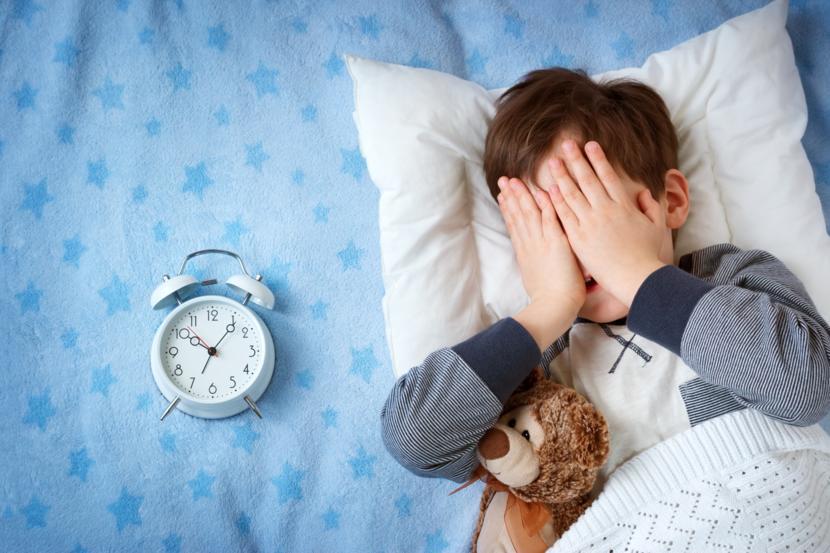Can Children Suffer from Sleep Apnea?

Sleep apnea is a very common sleep disorder that can affect any individual at any age, even children. It is typically caused by something that blocks the airway, thus leading to abnormal breathing while asleep. If your child snores loudly or displays other symptoms such as breathing difficulties while asleep, tossing and turning in bed, gasps and snorts, night sweats, and daytime sleepiness--all of these are recognized signs of sleep apnea. Research shows that up to 4 percent of children suffer from sleep apnea and many of them are between the ages of 2 and 8.
Children of a younger age have rather elastic rib cages. If you notice an inward movement of your child’s rib cage while they are breathing, this is known as a paradoxical movement. In such instances, your child may be working harder to breathe properly, thus triggering episodes of sleep apnea. Due to a lack of awareness, the majority of children with sleep apnea remain undiagnosed and therefore, left untreated. Children with untreated sleep apnea can endure significant consequences both physical and mental.
Poor sleep quality can affect a child’s learning and behavioral patterns. In fact, symptoms of poor sleep quality can manifest themselves into attention-deficit hyperactivity disorder or ADHD. This disorder is seen in 25 percent of children and it entails learning and behavioral problems, difficulty concentrating, as well as poor performance in school.
More so, a child with sleep apnea may possibly:
- Have difficulties waking up
- Have headaches in the morning
- Become groggy and agitated
- Sleepwalking in the middle of the night
- Wet the bed while asleep
- Portray a hyperactive behavior
- Fall asleep unintentionally while eating or drinking
- Speak with a nasal-like voice
- Undergo hormonal problems
- Undergo metabolic problems
In a few rare instances, sleep apnea in children can even be life-threatening.
Causes
The causes of sleep apnea in children and the causes of sleep apnea in adults greatly differ. In adults, the main risk factors include being over the age of 40, being overweight, or having a large neck. In children, however, the most common risk factors are having enlarged tonsils or adenoids, having a small jaw, having a long-term allergy, or suffering from a particular medical condition such as Down syndrome.
If your child has enlarged tonsils, they can cause breathing difficulties during the daytime. While they are asleep, the muscles in their body are relaxed, and thus, they trigger the tonsils to deny airflow into the upper respiratory system. This, in turn, causes episodes of sleep apnea.
Being obese (childhood obesity) is also a factor that greatly impacts sleep apnea. The fattier the tissues surrounding your child’s throat, the more likely it is that their breathing will become interrupted while they are asleep. Childhood obesity is more common in older children, ranging from the ages of 12-18.
If you fear that your child may be suffering from sleep apnea, it is imperative that you seek out a pediatrician who specializes in sleep disorders. Schedule an appointment with them and have them run an overnight polysomnogram on your child. A polysomnogram is an effective test that is used to confirm or rule out the existence of sleep apnea.
Pediatric polysomnograms are very similar to adult polysomnograms in that they both measure the same activities such as heart rate, breathing, and brain wave patterns, muscle movements, and the levels of oxygen in the blood. Due to the fact that most children may feel frightened or have trouble falling asleep while undergoing a polysomnogram, it is important for the pediatrician to ensure their safety and comfort. For this reason, you may be encouraged to stay by your child’s side and sleep next to them in a separate bed throughout the test.
Diagnosis and Treatment
Proper diagnosis for children with sleep apnea and adults with sleep apnea differ in the measurement of episodes.
- Adults - For adults, mild sleep apnea is measured by 5-14 episodes of disrupted breathing, followed by moderate sleep apnea with 15-30 episodes, and severe sleep apnea with 30 episodes or more.
- Children - For children, however, simply 1 episode is needed to pinpoint a positive diagnosis. Mild sleep apnea is measured by 1-5 episodes of interrupted breathing, followed by moderate sleep apnea with 5-15 episodes, and severe sleep apnea with 15 episodes or more.
Following the measurement of episodes of sleep apnea, the pediatrician will then determine whether your child needs to undergo treatment. In instances where your child is under the age of 12 and suffers from 5-15 episodes per night, treatment is highly recommended. However, the decision to treat children who experience 1-5 episodes per night has yet to be determined.
Not every child should undergo surgical treatment due to potential complications such as infection, bleeding, speech impediment, or airway complications. For this reason, a proper assessment of the risk factors, the child’s personal medical history, and their individualized needs all need to be taken into account before proceeding with treatment. If your child’s symptoms are mild, regular monitoring may be ordered before resorting to any surgical treatment.
Due to the fact that enlarged tonsils are the most common cause of sleep apnea in children, undergoing surgery to remove the tissues may be in order. This type of surgery is known as adenotonsillectomy, and most often, it alleviates the symptoms related to OSA in 70-90 percent of cases. However, ruling out any symptoms may not occur for 6-8 weeks following the surgical procedure.
Upon recovery, your child needs to be carefully monitored overnight to detect any breathing abnormalities or health-related complications. Keep in mind that even though the surgery may stop your child’s snoring, it does not guarantee a cure for sleep apnea. Moreover, depending on the type of sleep apnea your child has and whether or not it is caused by a structural problem with the jaw, throat, or face, different surgical procedures may be required.
On the off chance that adenotonsillectomy does not help to resolve your child’s symptoms, positive airway pressure (PAP) is a common treatment method that is typically recommended. PAP uses a machine hooked to a mask, which is to be worn over your child’s face. This mask keeps air flowing openly and prevents any unwanted episodes of sleep apnea.
If your child’s sleep apnea is associated with obesity, there are several lifestyle programs available to help your child maintain a healthy weight. Such programs involve changes in diet, exercise routines, adequate sleep, and other techniques to help your child achieve the desired weight.
Other treatment methods that are especially helpful in particular cases of pediatric sleep apnea include mouth appliances and breathing devices. In cases where respiratory disorders have impacted your child’s sleep apnea, asthma medications and inhalers can alleviate the symptoms. If, however, seasonal or environmental allergies aggravate your child’s symptoms of sleep apnea, there are several allergy medications that a doctor can recommend to improve their overall well-being.
You may not think much of your child’s snoring, but keep an eye out for any signs or symptoms of sleep apnea. This condition can be just as severe as in adults and may even lead to mental and behavioral problems. It is natural to want only the best for your child, so talk to a pediatrician right away if you believe sleep apnea is affecting your child. With proper treatment and support, you can help your child get the sleep that they deserve and wake up feeling energized.















